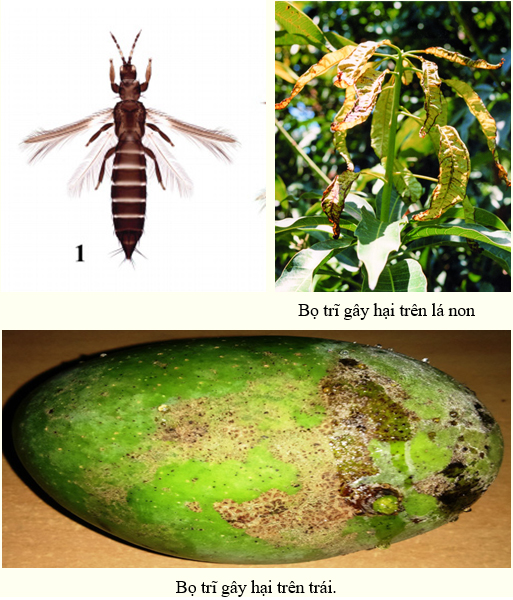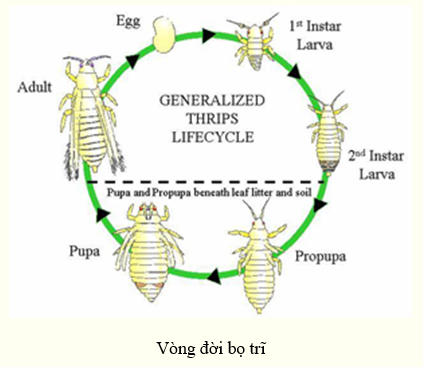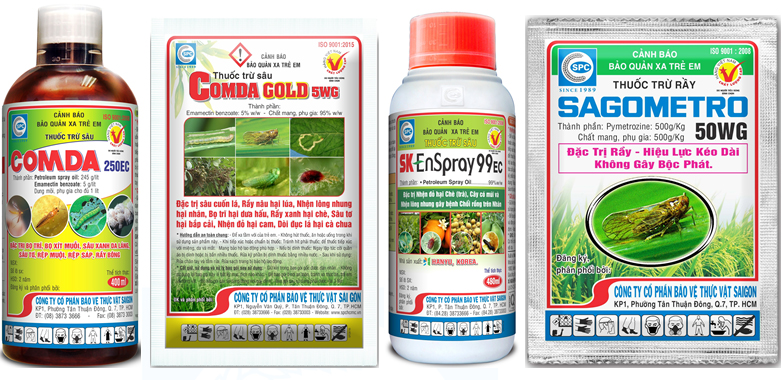|
Thrips causing damage on mango
17/12/2021
MSc Huynh Kim Ngoc Thrips are a common pest on mangoes, which are very small insects. However, it can be seen with the naked eye, the body is elongated, the mouth is very hard, strong, damaging by using the mouth to puncture the young parts of the tree such as young leaves, buds, flowers, fruit ... and then suck the sap. On the leaves, thrips sting on the underside of the leaves, making the leaves grow abnormally, curled, and the two edges cupped down. On the bud, the bud does not produce leaves or fruit. On flower, the flowers wilt, dry and then fall off in bulk. If it occurs on the fruit, it will make the left skin near the stem dark gray (bran skin), deformed fruit, if thrips appear in high density and cause late damage, the fruit skin, both young and large fruit will be lumpy. grain, the value of the product is reduced and cannot be exported. In addition to mango, thrips are also found harmful on many crops such as rice, oranges, tangerines, guava, cashew, watermelon, rice, vegetables of all kinds... Dry and hot weather are favorable conditions for thrips to develop, so in the South, thrips often appear and cause harm in hot months (from December to April next year), when This coincides with the period when mangoes are focusing on flowering (December-January) or are developing buds, leaves and young fruit (January-March), that is, the stages have an important influence on yield and quality. fruit matter. It should be noted that thrips have a relatively short life cycle of about 13-20 days, laying many eggs (25-30 eggs), so if not detected early and properly prevented, the damage will be more severe. Therefore, at these times, it is necessary to regularly visit the garden, investigate, if the tree has the symptoms as described and the thrips population is high (more than 3-5 individuals/bud, leaf or fruit), then conduct prevention immediately. To know if the number of thrips is high or low, we can use our hands to shake flowers, buds or fruits so that the thrips fall on a white sheet of paper and then observe and count with the naked eye or with a magnifying glass. Preventive measures: - Using a high-pressure sprayer, spray water on the plants to reduce the number of thrips. - In the period when mango is producing young leaves, buds, flowers, young fruits... if the thrips population is high, the following products can be alternately used: Sairifos 585EC, SK Enspray 99EC mineral oil (can be used alone or mixed with other ingredients). each other), Comda 250EC and Comda Gold 5WG, Secsaigon 10 EC, Secsaigon 25EC, Sagometro 50 WG. Attention should be paid to prevent thrips safely and effectively: (first). Spray with plenty of water (2). Thoroughly spray the underside of leaves where thrips hide (3). To avoid product resistance, it is recommended to alternate chemical products of different origin, can use the product 2-3 times in a row, about 1 week apart each time. (4). Only use products when the population of thrips is higher than 3-5 individuals/bud, leaf, fruit. (5). If the mango is flowering, you should limit spraying, if it is absolutely necessary |
To prevent, in addition to plowing and burying weed seeds, collecting weed stalks and stumps left after tilling the land to burn, not letting weeds produce seeds in production fields, etc., the use of chemical products is still a measure. optimal because of its ability to thoroughly kill weeds, reduce labor and take advantage of more time than manual weeding.
Miner has the scientific name Phyllocnistis citrella Staint., family Phyllocnistidae, order Lepidoptera. The miner occurs in many countries in the tropics and subtropics. The main host of the miner is the citrus family - Rutaceae. In addition, the miner also attacks mangosteen and some other plants.
Adult is a small planthopper, with a body 2-3 mm long, the whole body is ash gray, slightly greenish, the wings are opaque with many small brown spots.Eggs are oval, 0.3 mm long, have a pointed end and are attached directly to the leaf surface, leaf axils.
Green bugs specialize in the fruit of citrus groups (oranges, tangerines, lemons, grapefruits, kumquats...), some people call them orange bugs, or orange suckers. Their scientific name is Rhynchocoris poseidon or Rhynchocoris humeralis.
In Vietnam, yellow leaf curl disease is very common on papaya trees, especially the disease is often severe in areas of high and continuous planting, areas with hot and arid climates. The disease has significantly reduced the yield and quality of papaya. Gardens that are infected early when the plants are young may not yield. However, up to now, many gardeners still do not know the cause and how to fix it.
Spider mites are common pests on citrus trees, especially in hot and dry climates that are suitable for spiders to grow and cause severe damage.The group of harmful spiders is usually very small in size, unlike the natural enemy spiders.
This group includes species that are generally very small in size, causing damage by sucking plant sap (on leaves, fruits, branches, stems).
There are many species of mealybugs present on the group of Oranges,Tangerines,Grapefruits and Lemons (Citrus), which can be divided into 2 groups:
+ Group of sticky mealybugs with common varieties such as Lepidosaphes, Aonidiella, Coccus and Saissetia.
+ Group of flower mealybugs with common genera and species such as Pseudococcus, Planococcus and Icerya purchasi.
Dry branches and berries disease often appear to be common damage on coffee gardens during the rainy season. The disease causes death of branchs, dry fruit, severely affects the canopy structure and coffee yield if not paid attention to prevention.
Pink disease commonly causes diseases on rubber plantations in the rainy season, especially on garden from 4-8 years old. This year, rubber has to go through a period of severe drought, weakening the tree, so now in tnshe rainy season it is easy to get infected. Therefore, it is necessary to pay attention to good management to avoid affecting the garden.
In recent years, the area of citrus has been expanded because it is a fruit tree with high economic efficiency. However, in order to sell at a high price, not only in quality but consumers also require the external beauty of the fruit, so pest management on citrus is a matter of great concern to farmers. The hot season is a favorable condition for thrips to develop and cause damage, affecting the commercial value of fruit.
- Headquarters
- SAIGON PLANT PROTECTION JOINT STOCK COMPANY
- RQ 1, Nguyen Van Quy St., Tan Thuan Ward, HCM City
- Tax code: 0300632232
- Tel: (028) 38 733 295 - 38 732 077
- Fax: (028) 38 733 003 - 38 733 391
- Website: www.spchcmc.vn - Email: info@spchcmc.vn
- SAIGON PLANT PROTECTION COMPANY
- SAIGON PLANT PROTECTION JOINT STOCK ENTERPRISE
- Lot C1-C3 Hiep Phuoc Industrial Park, Hiep Phuoc Commune, HCM City
- Tel: (028) 3873 4089 - Fax: (028) 3873 4086
- Affiliated Unit
-
- Quick Links
- Home
- About us
- Career Opportunities














